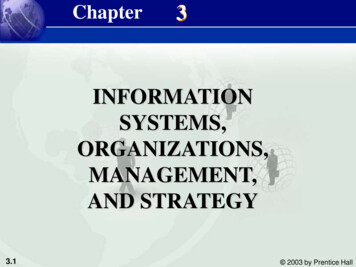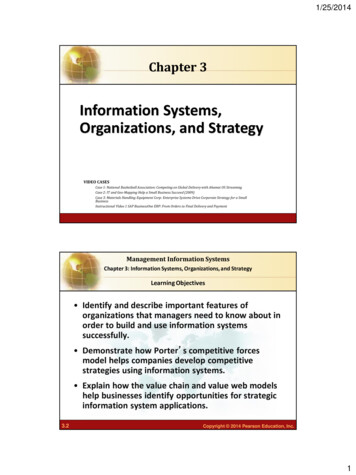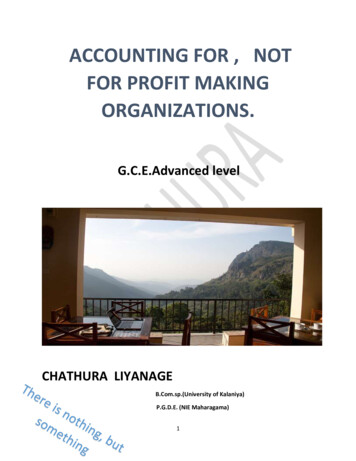
Transcription
T,AND STRATEGY3.1 2003 by Prentice Hall
Essentials of Management Information SystemsChapter 3 Information Systems , Organizations, Management, and StrategyOBJECTIVES What do managers need to know aboutorganizations in order to build and useinformation systems successfully? What impact do information systems haveon organizations? How do information systems support theactivities of managers in organizations?3.2 2003 by Prentice Hall
Essentials of Management Information SystemsChapter 3 Information Systems , Organizations, Management, and StrategyOBJECTIVES How can businesses use informationsystems for competitive advantage? Why is it so difficult to build successfulinformation systems, including systemsthat promote competitive advantage?3.3 2003 by Prentice Hall
Essentials of Management Information SystemsChapter 3 Information Systems , Organizations, Management, and StrategyMANAGEMENT CHALLENGES1. Sustainability of competitive advantage2. Fitting technology to the organization (orvice-versa)3.4 2003 by Prentice Hall
Essentials of Management Information SystemsChapter 3 Information Systems , Organizations, Management, and StrategyORGANIZATIONS AND INFORMATION SYSTEMSThe Two-Way Relationship Between Organizations and Information TechnologyORGANIZATIONSMEDIATING FACTORS:EnvironmentCultureStructureStandard ProceduresPoliticsManagement DecisionsChanceINFORMATIONTECHNOLOGYFigure 3-13.5 2003 by Prentice Hall
Essentials of Management Information SystemsChapter 3 Information Systems , Organizations, Management, and StrategyORGANIZATIONS AND INFORMATION SYSTEMSOrganization: Stable, formal structure Takes resources from environment andprocesses them to produce outputs3.6 2003 by Prentice Hall
Essentials of Management Information SystemsChapter 3 Information Systems , Organizations, Management, and StrategyORGANIZATIONS AND INFORMATION SYSTEMSTechnical Microeconomic Definition of the OrganizationFigure 3-23.7 2003 by Prentice Hall
Essentials of Management Information SystemsChapter 3 Information Systems , Organizations, Management, and StrategyORGANIZATIONS AND INFORMATION SYSTEMSBehavioral definition of Organization: Collection of rights, privileges, obligations,responsibilities Delicately balanced Conflict resolution3.8 2003 by Prentice Hall
Essentials of Management Information SystemsChapter 3 Information Systems , Organizations, Management, and StrategyCOMMON FEATURES OF ORGANIZATIONSThe Behavioral View of Organizations3.9Figure 3-3 2003 by Prentice Hall
Essentials of Management Information SystemsChapter 3 Information Systems , Organizations, Management, and StrategyORGANIZATIONS AND INFORMATION SYSTEMSCommon Features of Organizations Organizations are bureaucracies that havecertain structural features3.10 2003 by Prentice Hall
Essentials of Management Information SystemsChapter 3 Information Systems , Organizations, Management, and StrategyORGANIZATIONS AND INFORMATION SYSTEMSCommon Features of OrganizationsStructural Characteristics of Organizations: Clear division of labor Hierarchy Explicit rules and procedures Impartial judgments3.11 2003 by Prentice Hall
Essentials of Management Information SystemsChapter 3 Information Systems , Organizations, Management, and StrategyORGANIZATIONS AND INFORMATION SYSTEMSCommon Features of OrganizationsStructural Characteristics of Organizations(cont.): Technical qualifications Maximum organizational efficiency3.12 2003 by Prentice Hall
Essentials of Management Information SystemsChapter 3 Information Systems , Organizations, Management, and StrategyORGANIZATIONS AND INFORMATION SYSTEMSCommon Features of OrganizationsStandard Operating Procedures: Precise rules, procedures, and practices Enable organizations to cope with allexpected situations3.13 2003 by Prentice Hall
Essentials of Management Information SystemsChapter 3 Information Systems , Organizations, Management, and StrategyORGANIZATIONS AND INFORMATION SYSTEMSCommon Features of OrganizationsOrganizational Politics: Divergent viewpoints leads to politicalstruggle, competition, and conflict Hamper organizational change3.14 2003 by Prentice Hall
Essentials of Management Information SystemsChapter 3 Information Systems , Organizations, Management, and StrategyORGANIZATIONS AND INFORMATION SYSTEMSCommon Features of OrganizationsOrganizational Culture: a set offundamental assumptions about: What products the organization shouldproduce How and where it should produce them For whom they should be produced3.15 2003 by Prentice Hall
Essentials of Management Information SystemsChapter 3 Information Systems , Organizations, Management, and StrategyORGANIZATIONS & INFORMATION SYSTEMSOrganization and Its EnvironmentFigure 3-43.16 2003 by Prentice Hall
Essentials of Management Information SystemsChapter 3 Information Systems , Organizations, Management, and StrategyTHE CHANGING ROLE OF INFORMATION SYSTEMS IN ORGANIZATIONSInformation Technology Infrastructure and Information Technology ServicesInformation systems department: Formal organizational unit Responsible for information systems inthe organization3.17 2003 by Prentice Hall
Essentials of Management Information SystemsChapter 3 Information Systems , Organizations, Management, and StrategyTHE CHANGING ROLE OF INFORMATION SYSTEMS IN ORGANIZATIONSInformation Technology ServicesFigure 3-53.18 2003 by Prentice Hall
Essentials of Management Information SystemsChapter 3 Information Systems , Organizations, Management, and StrategyTHE CHANGING ROLE OF INFORMATION SYSTEMS IN ORGANIZATIONSInformation Technology Infrastructure and Information Technology ServicesIncludes specialists: Programmers: Highly trained, writesoftware Systems analysts: Translate businessproblems into solutions, act as liaisonsbetween the information systemsdepartment and rest of the organization3.19 2003 by Prentice Hall
Essentials of Management Information SystemsChapter 3 Information Systems , Organizations, Management, and StrategyTHE CHANGING ROLE OF INFORMATION SYSTEMS IN ORGANIZATIONSInformation Technology Infrastructure and Information Technology ServicesSpecialists (cont.): Information system managers:Leaders of various specialists Chief information officer (CIO): Seniormanager in charge of information systemsfunction in the firm End users: Department representatives3.20outside the information systemdepartment for whom applications aredeveloped 2003 by Prentice Hall
Essentials of Management Information SystemsChapter 3 Information Systems , Organizations, Management, and StrategyTHE CHANGING ROLE OF INFORMATION SYSTEMS IN ORGANIZATIONSHow Information Systems Affect OrganizationsEconomic theories Information technology is a factor ofproduction, like capital and labor3.21 2003 by Prentice Hall
Essentials of Management Information SystemsChapter 3 Information Systems , Organizations, Management, and StrategyTHE CHANGING ROLE OF INFORMATION SYSTEMS IN ORGANIZATIONSHow Information Systems Affect OrganizationsTransaction cost theory: Firms canconduct marketplace transactionsinternally more cheaply to grow larger3.22 2003 by Prentice Hall
Essentials of Management Information SystemsChapter 3 Information Systems , Organizations, Management, and StrategyTHE CHANGING ROLE OF INFORMATION SYSTEMS IN ORGANIZATIONSTransaction Cost Theory3.23Figure 3-6 2003 by Prentice Hall
Essentials of Management Information SystemsChapter 3 Information Systems , Organizations, Management, and StrategyTHE CHANGING ROLE OF INFORMATION SYSTEMS IN ORGANIZATIONSHow Information Systems Affect Organizations Agency theory: Firm is nexus ofcontracts among self-interested partiesrequiring supervision3.24 2003 by Prentice Hall
Essentials of Management Information SystemsChapter 3 Information Systems , Organizations, Management, and StrategyTHE CHANGING ROLE OF INFORMATION SYSTEMS IN ORGANIZATIONSAgency Cost Theory3.25Figure 3-7 2003 by Prentice Hall
Essentials of Management Information SystemsChapter 3 Information Systems , Organizations, Management, and StrategyTHE CHANGING ROLE OF INFORMATION SYSTEMS IN ORGANIZATIONSHow Information Systems Affect OrganizationsBehavioral theories: Information technology could changehierarchy of decision making Lower cost of information acquisition Broadens the distribution of information3.26 2003 by Prentice Hall
Essentials of Management Information SystemsChapter 3 Information Systems , Organizations, Management, and StrategyTHE CHANGING ROLE OF INFORMATION SYSTEMS IN ORGANIZATIONSHow Information Systems Affect OrganizationsVirtual organization: Task force networked organizations Uses networks to link people, assets, andideas to create and distribute productsand services without being limited tophysical locations3.27 2003 by Prentice Hall
Essentials of Management Information SystemsChapter 3 Information Systems , Organizations, Management, and StrategyMANAGERS, DECISION MAKING, AND INFORMATION SYSTEMSThe Role of Managers in OrganizationsClassical model of management: Traditional description of management Focuses on formal functions: plan,organize, coordinate, decide, controlBehavioral model of management: Describes management based onobservations of managers on the job3.28 2003 by Prentice Hall
Essentials of Management Information SystemsChapter 3 Information Systems , Organizations, Management, and StrategyMANAGERS, DECISION MAKING, AND INFORMATION SYSTEMSManagers and Decision MakingProcess of Decision Making Strategic Decision Making:Determines long-term objectives,resources, and policies Management Control: Monitorseffective or efficient usage of resourcesand performance of operational units3.29 2003 by Prentice Hall
Essentials of Management Information SystemsChapter 3 Information Systems , Organizations, Management, and StrategyMANAGERS, DECISION MAKING, AND INFORMATION SYSTEMSManagers and Decision Making Operational control: Determines how toperform specific tasks set by strategic andmiddle-management decision makers Knowledge-level decision making:Evaluates new ideas for products,services, ways to communicate newknowledge, ways to distributeinformation3.30 2003 by Prentice Hall
Essentials of Management Information SystemsChapter 3 Information Systems , Organizations, Management, and StrategyMANAGERS, DECISION MAKING, AND INFORMATION SYSTEMSManagers and Decision MakingDecisions are classified as: Unstructured: Non routine, decisionmaker provides judgment, evaluation, andinsights into problem definition, noagreed-upon procedure for decisionmaking Structured: Repetitive, routine, handledusing a definite procedure3.31 2003 by Prentice Hall
Essentials of Management Information SystemsChapter 3 Information Systems , Organizations, Management, and StrategyMANAGERS, DECISION MAKING, AND INFORMATION SYSTEMSStages of Decision Making Intelligence: Collect information, identifyproblem Design: Conceive alternative solution toa problem Choice: Select among the alternativesolutions Implementation: Put decision into effect3.32and provide report on the progress ofsolution 2003 by Prentice Hall
Essentials of Management Information SystemsChapter 3 Information Systems , Organizations, Management, and StrategyMANAGERS, DECISION MAKING, AND INFORMATION SYSTEMSDecision-Making Process3.33Figure 3-10 2003 by Prentice Hall
Essentials of Management Information SystemsChapter 3 Information Systems , Organizations, Management, and StrategyMANAGERS, DECISION MAKING, AND INFORMATION SYSTEMSModels of Decision Making Rational: People, organizations, andnations engage in consistent, valuemaximizing calculations or adaptationswithin certain constraints Cognitive style: Underlying personalitydispositions toward the treatment ofinformation, selection of alternatives, andevaluation of consequences3.34 2003 by Prentice Hall
Essentials of Management Information SystemsChapter 3 Information Systems , Organizations, Management, and StrategyMANAGERS, DECISION MAKING, AND INFORMATION SYSTEMSModels of Decision Making Systematic decision makers:Cognitive style, describes people whoapproach a problem by structuring it interms of some formal method Intuitive: Cognitive style, describespeople approaching a problem withmultiple methods in an unstructuredmanner3.35 2003 by Prentice Hall
Essentials of Management Information SystemsChapter 3 Information Systems , Organizations, Management, and StrategyMANAGERS, DECISION MAKING, AND INFORMATION SYSTEMSModels of Decision Making Organizational models of decisionmaking: Consider structural and politicalcharacteristics of an organization3.36 2003 by Prentice Hall
Essentials of Management Information SystemsChapter 3 Information Systems , Organizations, Management, and StrategyMANAGERS, DECISION MAKING, AND INFORMATION SYSTEMSImplications for the Design and Understanding of Information SystemsFactors to consider while planning anew system: Organizational environment Organizational structure, hierarchy,specialization, standard operatingprocedures3.37 2003 by Prentice Hall
Essentials of Management Information SystemsChapter 3 Information Systems , Organizations, Management, and StrategyMANAGERS, DECISION MAKING, AND INFORMATION SYSTEMSImplications for the Design and Understanding of Information Systems Culture and politics of the organization Type of organization and its style ofleadership3.38 2003 by Prentice Hall
Essentials of Management Information SystemsChapter 3 Information Systems , Organizations, Management, and StrategyMANAGERS, DECISION MAKING, AND INFORMATION SYSTEMSImplications for the Design and Understanding of Information Systems Groups affected by the system and theattitudes of workers who will be using thesystem Kinds of tasks, decisions, and businessprocesses, information system isdesigned to assist3.39 2003 by Prentice Hall
Essentials of Management Information SystemsChapter 3 Information Systems , Organizations, Management, and StrategyMANAGERS, DECISION MAKING, AND INFORMATION SYSTEMSImplications for the Design and Understanding of Information SystemsCharacteristics to be kept in mindwhile designing systems: Flexibility and multiple options forhandling data and evaluating information Capability to support a variety of styles,skills, and knowledge3.40 2003 by Prentice Hall
Essentials of Management Information SystemsChapter 3 Information Systems , Organizations, Management, and StrategyMANAGERS, DECISION MAKING, AND INFORMATION SYSTEMSImplications for the Design and Understanding of Information Systems Capability to keep track of manyalternatives and consequences Sensitivity to the organization’sbureaucratic and political requirements3.41 2003 by Prentice Hall
Essentials of Management Information SystemsChapter 3 Information Systems , Organizations, Management, and StrategyINFORMATION SYSTEMS AND BUSINESS STRATEGYWhat is Strategic Information System Computer system at any level of anorganization Changes goals, operations, products,services, or environmental relationships Helps organization gain a competitiveadvantage3.42 2003 by Prentice Hall
Essentials of Management Information SystemsChapter 3 Information Systems , Organizations, Management, and StrategyINFORMATION SYSTEMS AND BUSINESS STRATEGYBusiness Level Strategy and the Value Chain ModelDigital firms Manage the supply chain by buildingefficient customer “sense and response”systems Participate in “value webs” to deliver newproducts and services3.43 2003 by Prentice Hall
Essentials of Management Information SystemsChapter 3 Information Systems , Organizations, Management, and StrategyINFORMATION SYSTEMS AND BUSINESS STRATEGYBusiness Level Strategy and the Value Chain ModelValue Chain Model: Highlights the primary or supportactivities adding a margin of value toproducts or services Helps achieve a competitive advantage3.44 2003 by Prentice Hall
Essentials of Management Information SystemsChapter 3 Information Systems , Organizations, Management, and StrategyINFORMATION SYSTEMS AND BUSINESS STRATEGYBusiness Level Strategy and the Value Chain ModelPrimary Activities: Directly related to the production anddistribution of a firm’s products or servicesSupport Activities: Make the delivery of primary activitiespossible Consist of the organization’s infrastructure,human resources, technology, andprocurement3.45 2003 by Prentice Hall
Essentials of Management Information SystemsChapter 3 Information Systems , Organizations, Management, and StrategyINFORMATION SYSTEMS AND BUSINESS STRATEGYFirm Value ChainFigure 3-113.46 2003 by Prentice Hall
Essentials of Management Information SystemsChapter 3 Information Systems , Organizations, Management, and StrategyINFORMATION SYSTEMS AND BUSINESS STRATEGYBusiness Level Strategy and the Value Chain ModelValue Web: Customer-driven network of independentfirms Uses information technology tocoordinate value chains for collectivelyproducing a product or service3.47 2003 by Prentice Hall
Essentials of Management Information SystemsChapter 3 Information Systems , Organizations, Management, and StrategyINFORMATION SYSTEMS AND BUSINESS STRATEGYThe Value WebFigure 3-123.48 2003 by Prentice Hall
Essentials of Management Information SystemsChapter 3 Information Systems , Organizations, Management, and StrategyINFORMATION SYSTEMS AND BUSINESS STRATEGYBusiness Level Strategy and the Value Chain ModelProduct Differentiation: Competitive strategy Creates brand loyalty by developing newand unique products and services Products and services not easilyduplicated by competitors3.49 2003 by Prentice Hall
Essentials of Management Information SystemsChapter 3 Information Systems , Organizations, Management, and StrategyINFORMATION SYSTEMS AND BUSINESS STRATEGYBusiness Level Strategy and the Value Chain ModelFocused Differentiation: Competitive strategy Enables development of new marketniches for specialized products orservices Helps businesses compete better thancompetitors in the target areas3.50 2003 by Prentice Hall
Essentials of Management Information SystemsChapter 3 Information Systems , Organizations, Management, and StrategyINFORMATION SYSTEMS AND BUSINESS STRATEGYSupply Chain Management and Efficient Customer Response SystemEfficient Customer Response System: Directly links consumer behavior back todistribution, production, and supplychains3.51 2003 by Prentice Hall
Essentials of Management Information SystemsChapter 3 Information Systems , Organizations, Management, and StrategyINFORMATION SYSTEMS AND BUSINESS STRATEGYSupply Chain Management and Efficient Customer Response SystemSwitching costs: Expense incurred by a customer orcompany in terms of time and expenditureof resources when changing from onesupplier or system to another3.52 2003 by Prentice Hall
Essentials of Management Information SystemsChapter 3 Information Systems , Organizations, Management, and StrategyINFORMATION SYSTEMS AND BUSINESS STRATEGYStockless Inventory Compared to Traditional and Just-in-time Supply Methods3.53Figure 3-13 2003 by Prentice Hall
Essentials of Management Information SystemsChapter 3 Information Systems , Organizations, Management, and StrategyINFORMATION SYSTEMS AND BUSINESS STRATEGYEnhancing Core Competencies3.54Figure 3-14 2003 by Prentice Hall
Essentials of Management Information SystemsChapter 3 Information Systems , Organizations, Management, and StrategyINFORMATION SYSTEMS AND BUSINESS STRATEGYFirm-Level Strategy and Information TechnologyCore Competency: Activity at which a firm excels as a worldclass leader Information system encouraging thesharing of knowledge across businessunits enhances competency3.55 2003 by Prentice Hall
Essentials of Management Information SystemsChapter 3 Information Systems , Organizations, Management, and StrategyINFORMATION SYSTEMS AND BUSINESS STRATEGYIndustry-Level Strategy and Information SystemsInformation partnership: Cooperative alliance formed between twoor more corporations for sharinginformation to gain strategic advantage Help firms gain access to new customers,creating new opportunities for crossselling and targeting products3.56 2003 by Prentice Hall
Essentials of Management Information SystemsChapter 3 Information Systems , Organizations, Management, and StrategyINFORMATION SYSTEMS AND BUSINESS STRATEGYIndustry-Level Strategy and Information SystemsThe competitive forces model: Describes the interaction of externalinfluences, specifically threats andopportunities, affecting an organization’sstrategy and ability to compete3.57 2003 by Prentice Hall
Essentials of Management Information SystemsChapter 3 Information Systems , Organizations, Management, and StrategyINFORMATION SYSTEMS AND BUSINESS STRATEGYPorter’s Competitive Forces Model3.58Figure 3-15 2003 by Prentice Hall
Essentials of Management Information SystemsChapter 3 Information Systems , Organizations, Management, and StrategyINFORMATION SYSTEMS AND BUSINESS STRATEGYNew Competitive Forces Model3.59Figure 3-16 2003 by Prentice Hall
Essentials of Management Information SystemsChapter 3 Information Systems , Organizations, Management, and StrategyINFORMATION SYSTEMS AND BUSINESS STRATEGYIndustry-Level Strategy and Information SystemsNetwork Economics: Model of strategic systems at the industrylevel Based on the concept of a network Adding another participant entails zeromarginal costs but can create much largermarginal gain3.60 2003 by Prentice Hall
Essentials of Management Information SystemsChapter 3 Information Systems , Organizations, Management, and StrategyINFORMATION SYSTEMS AND BUSINESS STRATEGYUsing Systems for Competitive Advantage: Management IssuesManaging strategic transitions: Movement from one level ofsociotechnical system to another Required when adopting strategicsystems demanding changes in the socialand technical elements of an organization3.61 2003 by Prentice Hall
T,AND STRATEGY3.62 2003 by Prentice Hall
Essentials of Management Information Systems Chapter 3 Information Systems , Organizations, Management, and Strategy Operational control: Determines how to perform specific tasks set by strategic and middle-management decision makers Knowledge-level decision making: Evaluates










